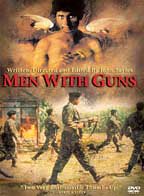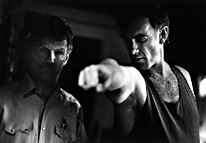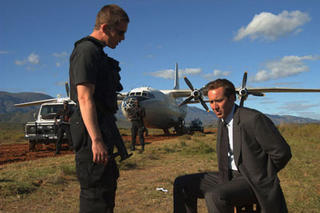
Over the four-year span between 1985 and 1989, two films were released revolving around the innovative concept of male teenagers traveling through time to better the future. The two films in discussion are
Back to the Future (1985) and
Bill & Ted’s Excellent Adventure (1989), both comedy/teen-film/science fiction/fantasy hybrids whose unconventional protagonists are ‘slackers’ given the efficacy to travel through time and alter history. The title characters of
Bill & Ted are considerably more dimwitted and stereotypically slackers of the wasted adolescence sense than Marty McFly, the lead of
Back to the Future.
Bill & Ted also exhibits a satirical and goofy tone in comparison to
Back to the Future’s earnestness and endearing sentimentality. In
Back to the Future, Marty is flung back to 1955 and unintentionally embarks on a quest to rectify the mistakes of his parents’ youth, thus ensuring a more favorable future for his family; whereas Bill & Ted are sent hurtling through different periods of time in an effort to pass their history final enabling them to one day create the rock music that will save the world.
Both films proved to be enormous hits spawning franchises comprised of sequels, animated series and video games. Considering the immediate and immense popularity of
Back to the Future, it is easy to contest that
Bill & Ted is merely piggybacking on its success with an easy cash-in formula. While it is no question that surely
Back to the Future influenced
Bill & Ted’s creation (in addition to the success of
Fast Times at Ridgemont High’s star slacker Jeff Spicoli) there is the unavoidable issue of the two films being birthed during the specific time period of the mid-to-late 1980’s. From a teleological standpoint, three predominant themes can be discerned within both texts: slacker sub-culture, 1980s politics, and rock-and-roll.
The character of the ‘slacker’ has come to be associated with the Generation X culture, an image fostered by Douglas Coupland’s novel, “Generation X,” (1991) and Richard Linklater’s film,
Slacker (1991). Generation X has often been distinguished as a generation raised more out of publicity than actual cultural behavior and it is difficult to determine exactly when this generation was established, much less what it should be called. The members of this generation have long been characterized as struggling to find an identity. Not surprisingly there have been numerous terms used to define the cultural movement including: the “13th Generation,” the “Why Bother? Generation,” the “Cocktail Generation,” the “Invisible Generation,” and the “Baby Bust Generation,” in response to the Baby Boomers and the subsequent and surprising decrease in birth rate in the mid-to-late 1960s.
[1] There has also been much debate over what years define the applicable period for the birth of Gen Xers but most will concede that the years between 1960 and 1975 are approximate enough. Geoffrey Holtz cites the advancements in birth control, abortion and surgical sterilization as some of the prime factors in the downward trend in child birth: “During the seventies 10 million people made sure that they would never have another child. America’s love affair with its children was, at least for now, a thing of the past.”
[2]Generation X has come to represent the pinnacle in the broken-home movement, “1975 saw a million married couples split up, with more than 1.1 million children touched by the social phenomenon.”
[3] The theme of divorce and family dysfunction is extremely prevalent in
Back to the Future and more obliquely so in
Bill & Ted. In the latter, both Bill and Ted appear to have been raised in single-father households. The absence of their birth mothers is never explained but divorce and parental apathy is assumed. While Ted has only his stern and distant father who threatens to exile Ted to military school, Bill has to deal with his father’s new wife, a fresh-out-of-high school beauty who used to share a class with the boys. The familial disharmony presented here is never remarked upon and hardly rectified by the film’s end as the two fathers’ appear at Bill & Ted’s history presentation and smile approvingly amidst their shock, but the only implied effect this will have on their paternal relationship is Ted escaping the murky depths of military school.
Back to the Future considers the role of family more optimistically and secularly. Initially, Marty accidentally ruptures his parents meeting and subsequent falling in love, causing the potential finality of his being “erased from existence” as a result. Ultimately, Marty’s dabbling with fate turns out favorably as he is given the supreme ability of teaching his father (as a teenager) some important life lessons that result in a more pleasant existence for his entire family when he manages to return to 1985. In a moment of supreme irony, Marty’s father in 1955 says goodbye to his son with, “I want to thank you for all your good advice. I’ll never forget it.”
In contrast to the film’s frivolous nature, Bill & Ted are delivered a more serious mission than Marty considering the fate of all mankind rests in their unlikely hands. While Marty’s journey is one of parental-discovery and contained improvement, Bill & Ted are sentenced on the path of self-discovery so that they can eventually instill peace and tranquility upon the world. In both situations, none of the time-traveling teens consider their mission with as much magnitude as the situation should dictate.
Ambivalence and disregard for society are two frequently used characteristics to describe the slacker. The term ‘slacker’ had existed in the vernacular long before it became associated so intricately with the Generation Xers. In fact, “it was used primarily to describe soldiers who put forth the minimum effort or conspired to do even less than that.”
[4] Lynnea Chapman King cites a look at the term from a more applicable viewpoint:
The dictionary defines slackers as people who evade duties and responsibilities. A more modern notion would be people who are ultimately being more responsible to themselves and not wasting their time in a realm of activity that has nothing to do with who they are or what they might ultimately be striving for.
[5]This definition marks the eventual actions of Bill, Ted and Marty McFly as very problematic within this context of slackerdom. As a result, we can look at the three teenagers as reformed slackers as both films begin with them embodying the slacker mold by virtue of their almost exclusive interest in making rock-and-roll music contrasted with their minimal concern for the institutions of school and family. Within the first ten minutes of
Back to the Future, Marty is immediately belittled by his principle for being a slacker who will never amount to anything.
This is a sentiment that has been constantly shoved upon the Generation Xers whose experience with futility has been accentuated by their holding witness to the growing divorce rates, failure of Vietnam and subordination of the position of Presidency by way of scandal, ineffectiveness and assassination. It is no surprise that the Generation Xers have adopted the strategy of “always hedge one’s bets, hold back a little... It’s all right to invest oneself in something as long as you realize that there is nothing really to invest.”
[6] Marty and Bill & Ted embody this notion through their lackadaisical approach to music production. When Marty’s girlfriend urges him to send a demo tape of his band to record companies, Marty whines, “What if they say I’m no good? What if they say get out of here kid, you’ve got no future. I just don’t think I could handle that type of rejection.” Bill & Ted echo an even more defeatist approach by not even attempting to learn to play their guitars. For the majority of the film, they are more than content playing “air guitar,” a facetious act that will always yield favorable results and completely eliminates the possibility of failure.

When it comes to altering history, these slackers do not always act as safely as one might hope they would. Bill & Ted consistently goof off throughout the many time periods, whether it be indulging in an old-fashioned barroom brawl or dressing up in knight’s armor and emulating
Star Wars. Not to mention that they entrust Ted’s 10-year old brother to watch over Napoleon while they continue gathering up other historical personalities. Marty exercises more understanding of the situation’s severity but nevertheless makes questionable decisions like jeopardizing the possibility of making it to the town square on time by letting himself get goaded into playing one more rock-and-roll song at the high school dance. That marks the first in a series of questionable decisions concerning his extremely finite chance to return home to 1985: not only does he play one more song but he takes the time to change his clothes before making it to the meeting point, “What, did you think I was gonna go back in that zoot suit?” Lastly, Marty awards himself only ten extra minutes to go back and attempt to save Doc’s life. Even though he prefaces with the insightful statement “I got all the time I want, I got a time machine,” he still decides that a mere ten minutes should suffice.
Carelessness aside, Marty does manage to save Doc’s life and once again we see the influence of youth on his elder. In 1955, Doc expresses a similar sense of gratitude as Marty’s father did regarding the impact Marty has had on the past, “You’ve really made a difference on my life. You’ve given me something to shoot for.” Here we return to the contradictory prospect of the slacker being given, and accepting, the ability to exact change on the community. This idea of the everyman being elevated to a position more esteemed than would be expected of him and managing to make a distinct impact on society is comparable to figures that could be found in both American politics and rock-and-roll cultures of the time period these films were released: most precisely, Ronald Reagan and Bruce Springsteen.
Ted V. McAllister has compared Reagan’s surprising ascension to the role of presidency to the plot of the Hollywood film
Mr. Smith Goes to Washington (1939), “we find a hard-working, patriotic citizen, called out of private life to serve in the far-off capital.”
[7] This can be directly related to the role of Marty McFly, who is an average teenager temporarily called into the role of time traveler to make some minor changes to history before being returned home to reap the benefits of his labors. The image of Ronald Reagan even plays a role within the film. First we see that the local movie theater is playing
Cattle Queen of Montana (1954) and his name is displayed predominantly on the marquee. His name is mentioned again, this time verbally, when the skeptical Doc Brown of 1955 asks for the president of 1985 as proof of the future: “Ha! Ronald Reagan! The Actor! Then who’s vice president? Jerry Lewis?”
These satirical jabs at Reagan’s public image can be taken a number of ways. If they are to be construed as playful, they can be correlated to Reagan’s image of populism. Around the time of Marty’s age, it has been purported that the youth “were quick to embrace the stability that Ronald Reagan represented… Reagan was hailed as a return to normalcy after a decade and a half of turmoil.”
[8] Marty might be proud to say that Reagan is his president and find it disheartening that the future president has not been taken seriously yet. There is also the element of Reagan’s pro-family relations agenda and the similar theme to the film. One of Reagan’s desires was to rectify what he believed were assaults on the family created by past governments, “not so much because they had espoused cultural or moral values but because they had caused inflation and bracket creep.”
[9] Economics is certainly an element in
Back to the Future, particularly displayed by the ending’s refurnished view of the present. Andrew Gordon illustrates this notion: “Marty’s story overcomes, through fantasy, the 1980’s fear of the loss of upward mobility in a period when the middle-class family was losing ground after twenty-five years of almost unbroken economic improvement.”
[10]It could also be construed as a more subversive reference to Reagan’s initial call for a return to fundamentals by his repeatedly referencing Puritan values and John Winthrop’s “City on a Hill,” ideology.
[11] Back to the Future suggests that a simple return to fundamentals is not remedy enough; instead the youth of the generation must physically go back and redefine the fundamentals if the country is destined to survive. While these readings can border on the tangential, politics is certainly present as a sub-text within the film. Aside from the references to Reagan, there is an ongoing, background sub-plot involving an African-American elevating from waiter to mayor of Hill Valley. Once again an ordinary man being called up to duty, however this time he is an African-American emerging out of an unforgiving time period.
Similarly, Bill & Ted are average teenagers who are destined to save the world with rock-and-roll and therefore align themselves slightly more with Bruce Springsteen than Reagan (interestingly enough Springsteen’s saxophonist, Clarence Clemons has an uncredited cameo as one of the leaders of the future, providing a direct connection to the musician). Grossberg explains, “the site of Springsteen’s popularity: to celebrate simultaneously one’s ordinariness and to assert one’s fantastic (and even fantasmatic) difference – the ordinary becomes extraordinary.”
[12] Although it can be criticized that Bill & Ted are below-average Americans, they still emulate the Reagan formula of being called up to duty by a higher power in order to change things for the better. There is no mention of Reagan in the film but his timely education budget cuts in 1987 may have some influence of the depiction of high school and its dim-witted students. Although the ultimate message may suggest that the youth of America will be able to find alternate ways of learning, even if the school institution is not adequate enough. Interestingly, Marty describes his trip as “educational” when he bids farewell to his parents in 1955.
The appreciation and distribution of rock-and-roll music plays an integral role in defining the personalities of Bill & Ted and Marty McFly. Both films introduce their lead characters in strikingly similar fashion: playing guitar so loudly that their amplifiers explode. It is explicitly reiterated that Bill & Ted change the world because of their rock-and-roll music but it is also suggested obliquely that one of Marty’s great contributions to history changing is jump-starting the rock-and-roll movement of the 1950s. On stage at the dance, Marty takes the opportunity to introduce everyone to “Johnny B. Good” causing a blowout of celebration on the dance floor and inspiring much livelier and athletic dance moves than during the previous song. Ultimately he goes overboard with 1980s style heavy metal guitar moves and showboating which eventually frightens the initially enthusiastic audience. Before this happens, there is a brief shot of the band leader, Marvin Berry, calling his cousin “Chuck” to make sure he hears the music. The inference here is that Marty inadvertently inspires Chuck Berry to write his classic rock-and-roll song. However, what, if any, sort of repercussions this has on the future is never explored. While Marty wisely decides to play a song that would be written relatively close to the time period he is currently residing in, one could assume that Chuck Berry might not wait the full three years until 1958 to write it if he is directly inspired enough in 1955. There is the distinct possibility that Marty must have changed the face of rock-and-roll music, however slightly, by introducing the song prematurely.
Bill & Ted’s contribution to rock-and-roll is given considerably more weight. We are told that their music will bring about universal harmony and turn the world into a much better place but the one scene in which Bill & Ted visit the future, the image is not necessarily as reassuring as it has been prophesied to be. The future is presented as robotic and innocuous. While there is certainly a mellow atmosphere and ethnic diversity is represented favorably, the location seems somewhat suffocating and cold. More disconcerting are the hoards of inarticulate people lined around the cave expressionlessly playing air guitar in synchronization and wearing nearly identical futuristic outfits giving the future a Fascist tone. “Ironically, this undermines the subversive appeal of rock music, which is no longer individualistic in the future but soulless.”
[13]This returns to the fundamentally different tones regarding the outlook of the future within the two films.
Bill & Ted is politically charged in that it addresses the growing concerns about dumb youth and the growing power of rock-and-roll music by making light of these concerns and creating a sardonic future in which the conservatives’ worst nightmare is realized.
Back to the Future is sociologically charged in that it responds to growing divorce rates and the apathetic youth image by presenting an optimistic and fairy-tale like representation in which the mistakes of the past can be amended in order to bolster the sacrament of family and make way for an encouraging future. A cynical view could still construe the ending of
Back to the Future as a grim warning against the preceding actions since Marty is whisked away to the future to rectify the problems that his own children will be facing. Here we have the problematic image of Marty having to save his family again, including the implicit message that he is responsible for this by turning into a lousy parent himself. However, the film presents the scene in a largely comedic way giving the impression that this should be construed more as another exciting adventure that can be solved as easily as the first. While the family may not be entirely immune at the film’s conclusion, the McFly family is represented considerably more stable than those of Bill & Ted. Both films clearly respond to a time in American history when the future of the world was very much uncertain due to war, family breakdown, school reform and an overwhelming sense that things were getting worse, not better.
ReferencesBimes, Teri. “Reagan: The Soft-Sell Populist,” in The Reagan Presidency: Pragmatic
Conservativism and Its Legacies, edited by W. Elliot Brownlee and Hugh Davis Graham. Kansas: University Press of Kansas, 2003.
Gordon, Andrew. “You’ll Never Get Out of Bedford Falls: The Inescapable Family in
American Science Fiction and Fantasy Films.” Journal of Popular Film & Television 20, no. 2 (Summer 1992) 2-11.
Grossberg, Lawrence. “Rockin' with Reagan or the Mainstreaming of Post-modernity.”
Cultural Critique 10 (Fall, 1988): 123-49.
Hanson, Peter. The Cinema of Generation X: A Critical Study of Films and Directors.
Jefferson, N.C.: McFarland & Company, Inc., 2002.
Heclo, Hugh. “Reagan and American Public Philosophy,” in The Reagan Presidency:
Pragmatic Conservativism and Its Legacies, edited by W. Elliot Brownlee and Hugh Davis Graham. Kansas: University Press of Kansas, 2003.
Holtz, Geoffrey T. Welcome to the Jungle: The Why Behind “Generation X”. New York:
St. Martin’s Griffen, 1995.
Hunter, IQ. “Banality as Saviour: Bill & Ted and The Matrix,” Filmhäftet 121 (May
2002)
. (5/3/05)
King, Lynnea Chapman. “Generation X: Searching for an Identity?” Post Script – Essays
in Film and the Humanities 19, no. 2 (2000): 8-16.
McAllister, Ted V. “Reagan and the Transformation of American Conservatism,” in The
Reagan Presidency: Pragmatic Conservativism and Its Legacies, edited by W. Elliot Brownlee and Hugh Davis Graham. Kansas: University Press of Kansas, 2003.
[1] Lynnea Chapman King, “Generation X: Searching for an Identity?” Post Script – Essays in Film and the Humanities 19, no. 2 (2000): 8.
[2] Geoffrey T. Holtz, Welcome to the Jungle: The Why Behind “Generation X” (New York : St. Martin’s Griffen, 1995), 19.
[3] Holtz, 26.
[4] Peter Hanson, The Cinema of Generation X (Jefferson, N.C.: McFarland & Company, Inc., 2002), 61.
[5] King, 13.
[6] Lawrence Grossberg, "Rockin' with Reagan or the Mainstreaming of Post-modernity," Cultural Critique 10 (Fall, 1988): 138.
[7] Ted V. McAllister, “Reagan and the Transformation of American Conservatism,” in The Reagan Presidency: Pragmatic Conservativism and Its Legacies, eds. W. Elliot Brownlee and Hugh Davis Graham (Kansas: University Press of Kansas, 2003), 49.
[8] Holtz, 194.
[9] Terri Bimes, “Reagan: The Soft-Sell Populist,” in The Reagan Presidency: Pragmatic Conservativism and Its Legacies, eds. W. Elliot Brownlee and Hugh Davis Graham (Kansas: University Press of Kansas, 2003), 70.
[10] Andrew Gordon, “You’ll Never Get Out of Bedford Falls: The inescapable family in American Science Fiction and Fantasy Films,” Journal of Popular Film & Television 20, no. 2 (Summer 1992): 8.
[11] Hugh Heclo, “Reagan and American Public Philosophy,” in The Reagan Presidency: Pragmatic Conservativism and Its Legacies, eds. W. Elliot Brownlee and Hugh Davis Graham (Kansas: University Press of Kansas, 2003), 21.
[12] Grossberg, 133.
[13] IQ Hunter, “Banality as Saviour: Bill & Ted and The Matrix,” Filmhäftet 121 (May 2002).






















